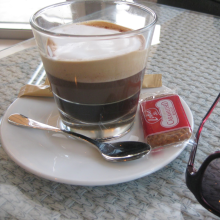Classical Relief II- October 4, 2017.
A feeling of comfort when something frightening, worrying, or painful has ended or has not happened; when something reduces someone’s pain or unhappy feelings.
Playlist:
1. Serenade for winds in E flat major, KV 375, 22:30.
2. Röslein Auf Der Heiden, 1:46.
3. Enfantillages Pittoresques, 3:33.
4. Pastorale, Op.147, 3:46.
5. 3 Poèmes de Stéphane Mallarmé L. 127, 8:18.
6. L’Automne op.115, 10:12.
7. Intermezzo A Major Op 118 No 2, 5:56.
8. The Four Seasons, In G Minor, Op.8, Summer, 1st movement, Allegro Non Molto-Allegro, 5:09.
9. Prospero’s last speech of The Tempest (Epilogue 1-20), 3:23.
10. Instrumentalstück (Canticles Of Ecstacy), 3:33.
11. Gnossienne No. 4, 2:44.
12. Intermezzo in B minor Op. 119, No. 1, 4:09.
13. Saeta (vinyl)(live), 4;21.
14. Prelude & Fugue No.5 in D major Op.87, 3:54.
15. G minor fugue BWV 541 No.2, 6:32.
16. Phrygian Gates, 10:02.
17. String Quartet No. 14 in C-sharp minor, Op. 131 (live), 39:07.
18. Intermezzo op.118 no.6 (live), 5:16.
19. Der Müller Und Der Bach, 3:51.
20. Three-Part Invention in G Minor, 2:50.
21. Levante, 3:58.
22. Toccata in D minor, BWV 913 (live), 12:40.
23. Prelude and Fugue in C minor, BWV 549, 6:19.
24. Etude Op.25 No.2, 1:31.
25. Donna Non Vidi Mai, 2:43.
Total Time, 2:57:04.
Notes:
9. “Prospero’s Speech” is the final soliloquy and epilogue lyrics by William Shakespeare, by Prospero in William Shakespeare’s play The Tempest. music & arr. by Loreena McKennitt, Released March 22, 1994.
10. Recorded June 1993 in the church of St. Pantaleon, Köln. Released 1994 by Deutsche Harmonia Mundi / BMG Classics (05472773202) in co-production with WDR Köln. Sequentia’s Hildegard von Bingen Project: Initially in collaboration with the West German Radio Cologne (WDR Köln) Sequentia made a series of recordings of the complete works of Germany’s most important medieval composer, the abbess and visionary Hildegard von Bingen (1098-1179). This CD was awarded an Edison Prize, a French ‘Disque d’Or’, and received Grammy nomination as best choral recording of 1993.
13. Saeta is an unaccompanied flamenco song whose origins can be traced to Sephardic songs from the 16th century. This short work is composed in a contemporary idiom and makes dramatic use of contrasting dynamics and explores different colours and timbres of the guitar.
15. Hans Andre Stamm plays bach on the newly renovated Trost-Organ in Waltershausen, Germany. “Why is this organ in Waltershausen nevertheless famous? Regarding this we should cite first of all Trost’s outstanding concept. Although the organ was made in the first third of the 18th century, it nevertheless has all the traits and delicateness of the gallant style. Trost enriched the organ making of his time enormously with new instrumental features which are also to be found in this organ. Furthermore, it has all of the features that marked organ building in Thuringia at this time: emphasis of the fundamental tonality and at the same time of solemnity, a great supply of labial eight foot voices in the manuals, transmission stops from the great organ to the pedals, mixtures with thirds, unusual stop designs such as Unda maris and Doppelflöte. It also has, however, typical long-established voices such as one expects to find in Thuringia: Violonbass, Viola di gamba, Flaute douce, Sesquialter, Cymbelstern. Naturally the sonorous lingual voices are there too, as Adling especially emphasised: « The work is very beautiful, especially the reeds pipes. » In general, Trost placed high value on the interior and exterior beauty of his organs as an expression of the aesthetics of the Age of Enlightenment.” http://mypipeorganhobby.blogspot.com/2009/05/waltershausen-1741-trost-organ-germany.html
20. The Swingle Singers – The Bach Album, Released: 1990.
21. Levante is a term used to refer to Spain’s Eastern coast. It takes its name from the wind that arrives in Spain from the direction of the Levante, the eastern coast of the Mediterranean. Although the Levante of Spain stretches from Barcelona to Almería, in flamenco it refers to a group of songs from eastern Andalucía, from Almería to Valencia, including Granada and Murcia. The flamenco songs from this region are known as Cantes de Levante, These forms are essentially Fandangos, and similar to the Fandangos de Málaga. What distinguishes the Cantes de Levante, apart from their source or subject matter, is their unique tonality, Tonos Tarantos, described in more detail below. There are many different Cantes de Levante. Some, including Murcianas, Cartageneras and Grana’inas are associated with a particular place. Others, like Tarantas/Tarantos, Mineras, and Fandangos Mineros are songs about miners’ experiences.
23. Recorded between 1997 and 2008, Gerhard Weinberger’s complete Bach organ music cycle may be the most comprehensive on the market. A special attraction for organ enthusiasts is the great organ by Gottfried Silbermann with its three Organ manuals and 2574 organ pipes. The gallery organ, built by Gottfried Silbermann, is not only the most important of the 30 organs built by the renowned organ builder, it is considered to be the one with the world’s best tonal structure since it incorporates both French and Saxon tonal elements.
24. Swingle Singers* – Swinging The Classics Swingle Singers; Released: 2009.
-Jone.
.


